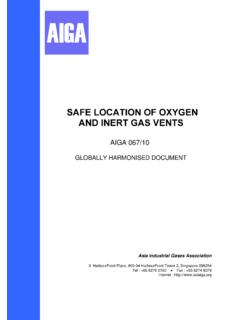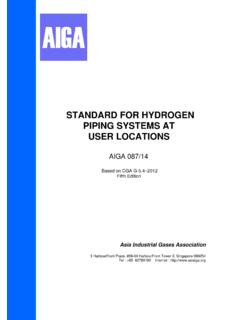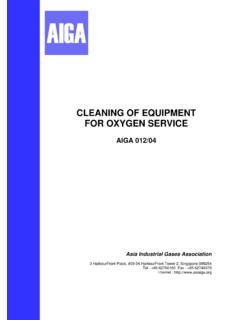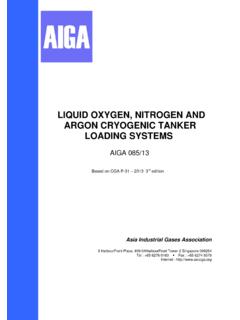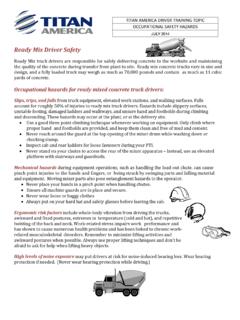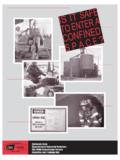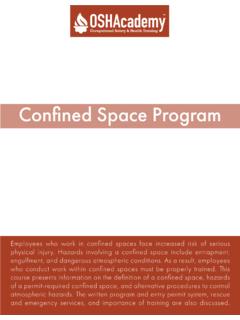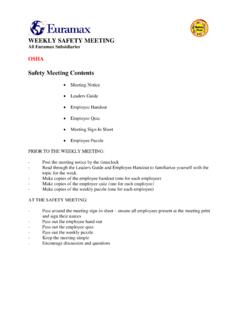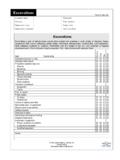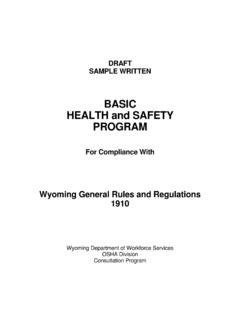Transcription of HAZARDS OF INERT GASES AND OXYGEN …
1 HAZARDS OF INERT GASES AND OXYGEN depletion AIGA 008/11 Asia Industrial GASES Association 3 HarbourFront Place, #09-04 HarbourFront Tower 2, Singapore 099254 Tel : +65 6276 0160 Fax : +65 6274 9379 Internet: Reproduced with permission from the European Industrial GASES Association. All rights reserved ASIA INDUSTRIAL GASES ASSOCIATION 3 HarbourFront Place, #09-04 HarbourFront Tower 2, Singapore 099254 Tel: +65 62760160 Fax: +65 62749379 Internet: AIGA 008/11 HAZARDS OF INERT GASES AND OXYGEN depletion PREPARED BY : ARRIETA, Angel PRAXAIR EUROHOLDING BRICKELL, Phil THE LINDE GROUP CAMPARADA, Vincenzo SOL FRY, Christina AIR PRODUCTS GACHOT, Roger AIR LIQUIDE LEWANDOWSKI, Janusz LINDE GAS NIELSEN, Arvid YARA PATEL, Milan AIR PRODUCTS RITLOP, Danilo MESSER GROUP Disclaimer All technical publications of AIGA or under AIGA s name, including Codes of practice, Safety procedures and any other technical information contained in such publications were obtained from sources believed to be reliable and are based on technical information and experience currently available from members of AIGA and others at the date of their issuance.
2 While AIGA recommends reference to or use of its publications by its members, such reference to or use of AIGA s publications by its members or third parties are purely voluntary and not binding. Therefore, AIGA or its members make no guarantee of the results and assume no liability or responsibility in connection with the reference to or use of information or suggestions contained in AIGA s publications. AIGA has no control whatsoever as regards, performance or non performance, misinterpretation, proper or improper use of any information or suggestions contained in AIGA s publications by any person or entity (including AIGA members) and AIGA expressly disclaims any liability in connection thereto. AIGA s publications are subject to periodic review and users are cautioned to obtain the latest edition.
3 AIGA 008/11 Acknowledgement This document is adopted from the European Industrial GASES Association document IGC Doc 44/09 HAZARDS of INERT GASES and OXYGEN depletion . Acknowledgement and thanks are hereby given to EIGA for permission granted for the use of their document. AIGA 008/11 Table of Contents 1 2 2 Scope and purpose .. 2 3 2 4 General Information about INERT GASES and OXYGEN depletion .. 2 OXYGEN is essential for life .. 3 INERT GASES give no warning .. 3 INERT GASES act quickly .. 3 The ambiguity of INERT 4 Watchfulness with regard to INERT GASES and OXYGEN depletion .. 4 5 Some typical situations with INERT gas and/or OXYGEN depletion 4 Confined or potentially confined spaces and enclosures.
4 4 The use of INERT cryogenic liquids ..4 Areas near where INERT GASES are vented or may collect .. 5 Use of INERT gas instead of air .. 5 Dangers of improper inhalation (abuse) of INERT 5 6 Hazard mitigation and preventive 6 Information, training .. 6 Proper installation and operation ..6 Identification and safeguarding of potentially hazardous 6 Ventilation and atmospheric monitoring for INERT GASES and OXYGEN deficiency .. 6 Ventilation/ monitoring of rooms which people regularly enter or work in .. 6 Ventilation/ monitoring prior to entry into confined spaces or enclosures .. 7 Ventilation/monitoring for entry into other spaces where INERT GASES may be 7 Notes on purging requirements.
5 8 Testing of OXYGEN content .. 8 Work 8 Lock-out Tag-out Protection of personnel .. 9 7 Confined space entry .. 9 8 Rescue and first-aid .. 9 Basic 10 Rescue plan elements ..10 Equipment .. 10 Rescue training .. 11 First Aid .. 11 9 Conclusions .. 11 10 References .. 11 Appendix A: Summary for operators .. 13 Appendix B1: Rescue considerations from normally accessible 16 Appendix B2: Rescue considerations from Confined 17 Appendix B3: Rescue considerations from pits, 18 Appendix C: Accidents involving OXYGEN deficiency .. 19 Appendix D: Hazard of INERT GASES sign .. 22 AIGA 008/11 2 1 Introduction AIGA is very concerned about the accidents that industrial gas companies and users of INERT GASES continue to report each year, where the direct cause has been lack of OXYGEN resulting in asphyxiation.
6 AIGA identified that existing information on the HAZARDS of INERT GASES was not sufficiently directed at the users who were most at risk. This document sets out the essential information that is necessary to prevent asphyxiation accidents involving INERT GASES . 2 Scope and purpose It is intended that this document is used as a training package suitable for supervisors, line managers, direct workers and users wherever INERT GASES are produced, stored, used, or where OXYGEN depletion could otherwise occur. This document has 4 parts: The main document is intended for line managers and supervisors and gives the background of the subject, the typical description of OXYGEN deficiency accidents and the recommended rescue preparations to be in place in case of accident.
7 Appendix A is a simplified summary of the main document, designed to be reproduced as a pamphlet for sharing with workers and end users. Appendix B gives an introduction to rescue considerations from normally accessible rooms, confined spaces or pits and trenches. Appendix C lists some actual accidents that have taken place in recent years, which can be used as examples to underline the potentially fatal HAZARDS of INERT GASES . Appendix D gives an example of a warning sign or poster to highlight the HAZARDS of INERT GASES and asphyxiating atmospheres. 3 Definitions Asphyxiation: the effect on the body of inadequate OXYGEN , usually resulting in loss of consciousness and/or death. This is also known as suffocation or anoxia.
8 Asphyxiant: any material which reduces the amount of available OXYGEN either by simple dilution or by reaction. INERT gas: A gas that is not toxic, which does not support human breathing and which reacts little or not at all with other substances. The common INERT GASES are nitrogen and the rare GASES like helium, argon, neon, xenon and krypton. Flammable gas: a gas whose major hazard is flammability. Note that all flammable GASES also act as asphyxiants. User: for the purpose of this document this term covers any individuals, companies or other organisations that make use of the products sold by industrial gas companies. Users may be, but are not necessarily, customers. 4 General Information about INERT GASES and OXYGEN depletion In spite of the wealth of information available, such as booklets, films and audio-visual aids, there are still serious accidents resulting in asphyxiation caused by the improper use of INERT GASES or by OXYGEN depletion .
9 It is therefore absolutely essential to draw attention to the HAZARDS of INERT GASES and OXYGEN depletion . Accidents due to OXYGEN depleted atmospheres are usually very serious and in many cases fatal. AIGA 008/11 3 Although carbon dioxide is not an INERT gas, most of the information in this document is applicable as it too will cause OXYGEN depletion . However, the specific HAZARDS and physiological effects of carbon dioxide are more complex than those of INERT GASES . This document does not cover these aspects. (See IGC Doc. 67 CO2 cylinders at user s premises for more details about the additional HAZARDS of carbon dioxide). OXYGEN is essential for life OXYGEN is the only gas that supports life.
10 The normal concentration of OXYGEN in the air we breathe is approximately 21 %. Concentration, thinking and decision-making are impaired when the OXYGEN concentration falls only slightly below this norm. These effects are not noticeable to the affected individual. If the OXYGEN concentration in air decreases or, if the concentration of any other GASES increase, a situation is rapidly reached where the risks of asphyxiation are significant. For this reason any depletion of OXYGEN below 21 % must be treated with concern: Asphyxia Effect of O2 Concentration (from NL/77 Campaign against Asphyxiation) O2 (Vol %) Effects and Symptoms 18-21 No discernible symptoms can be detected by the individual.
